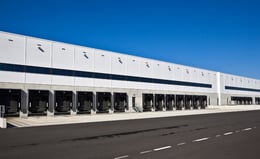The Most Common Supply Chain Disruptions
Nick Ostdick - October 10, 2017

.jpg?width=320&name=The%20Most%20Common%20Supply%20Chain%20Disruptions%20(1).jpg) Every year, today’s manufacturing companies dedicate time, resources, and personnel to devising planning and production strategies designed to reduce the likelihood of disruptions across each touch point of the value chain. Whether we’re discussing integrated planning platforms, intelligent production sequences, or transport logistics, the ability to react and correct disruptions at the production, inventory, or transportation level depends largely on understanding the kinds of disruptions and how at-risk a manufacturing company is to experiencing each type. Given the interconnected nature of today’s global supply chain and expansive network of production facilities, warehouses, and transportation hubs, there is more opportunity than ever before for manufacturing companies to encounter disruptions or breakdowns at more touch points across their supply network.
Every year, today’s manufacturing companies dedicate time, resources, and personnel to devising planning and production strategies designed to reduce the likelihood of disruptions across each touch point of the value chain. Whether we’re discussing integrated planning platforms, intelligent production sequences, or transport logistics, the ability to react and correct disruptions at the production, inventory, or transportation level depends largely on understanding the kinds of disruptions and how at-risk a manufacturing company is to experiencing each type. Given the interconnected nature of today’s global supply chain and expansive network of production facilities, warehouses, and transportation hubs, there is more opportunity than ever before for manufacturing companies to encounter disruptions or breakdowns at more touch points across their supply network.
However, this also means there is more information available for companies than ever before about the different breeds of supply chain disruptions and the methods companies can pursue to reduce the risk of these disruptions.
Whether the risks are internal (contained within a company’s operational walls and subject to mitigation by planners and managers) or external (factors outside a company’s control that can be difficult to properly prepare for, such as efficiency issues with suppliers or partners), the old mantra ‘knowledge is power’ goes a long way toward equipping manufacturing companies to navigate and overcome disruptions while ensuring the continuation of production programs to meet customer demands.
With this in mind, let’s examine the most common types of supply chain disruptions and how these disruptions present themselves in today’s global manufacturing sphere.
Response to technology trends
We’ve discussed at length in previous posts the need for manufacturers, suppliers, and other critical players in the automotive supply chain to ditch manual or Excel-based methods of demand planning, data analysis, and forecasting for integrated, intelligent planning software solutions. In an age when E2E visibility, transparency, and agility are key drivers in creating a lean, responsive supply stream, concepts like Industry 4.0, Big Data, The Internet of Things, and others are crucial to a company’s success in a worldwide production network. Today’s biggest technology trends, particularly in planning and production allocation such as Plan for Every Part and Every Part Every Interval, allow planners to view the entire supply situation and ensure the efficiency of production programs for on-time delivery and enhanced customer satisfaction. Responding to these often rapid developments in supply chain technology, can, if deployed without a comprehensive strategy, can result in disruptions as lag times as companies attempt to integrated new technologies with legacy systems.
Natural and environmental events
Firmly rooted in the external risk camp, natural or environmental disasters are one of the most difficult disruption risks to troubleshoot yet one of the most potentially damaging. Particularly as the impact of global climate change continues to ripple throughout the world, manufacturers need to be aware of their carbon footprint and the impact their operations have on the worldwide climate. In addition, companies must address the possibility of a natural disaster in creating and deploying their supply chain management platform. For example, a manufacturing company in Mexico must understand and account for the potential for an earthquake or drought and how these occurrences could damage their supply and production network, as well as proper contingency plans for maintaining production levels should these events take place.
Planning and forecasting
The ability to accurately plan for and forecast future demand based on past production and supply is perhaps one of the core drivers in avoiding disruption and promoting sustainable manufacturing programs. As we mentioned before, intelligent software solutions and their capacity for E2E visibility is a big part in accurate planning and forecasting, however, a fundamental understanding and strategizing of a manufacturing company’s supply situation and production capacity is also key in these efforts. Insight and understanding into the scope of a company’s production network - facility capacity, yard management, container management, and transportation management - are value-added propositions in assigning production programs to the right hub at the right time.
Governmental regulations
Another external risk for supply chain disruptions, governmental regulations and restrictions are quickly becoming a common hurdle companies have to overcome in their supply chain management strategy, especially as the global production network becomes more disparate and enters new and emerging markets. Taxations, trade restrictions, border controls, and labor laws are important elements planners and managers must address in crafting production and supply strategies. For example, a manufacturing company looking to transport component parts from a hub in Mexico to a facility in Dallas, Texas must account for additional lead times in U.S. customs inspections and regulations. Failure to address this additional stage in transportation and delivery could result in orders not being filled as scheduled.
Transportation and freight logistics
Fuel costs. Route efficiency. Port complications. Chassis vs. rail. These are just a few of the issues planners and managers must consider when strategizing ways to avoid disruptions when it comes to the transportation of products and parts to customers across the globe. While detailed metrics, analytics, and reporting can be critical value propositions in avoiding freight-based disruptions and leveraging lean transportation principles, a robust transportation management strategy should include contingency plans with freight partners to ensure the continued movement of products should a disruption occur.In addition, planners and managers must also consider container and yard management factors as they too can be critical in making sure the right component parts are in place at the right time for production programs.
LATEST POSTS
- Understand Circular Economy in The Manufacturing Industry
- How Can Industry 4.0 IT Integration Be Achieved Smoothly?
- The Significance of Order Sequencing in Discrete Manufacturing
- How to improve your Supply Chain Management: The Power of Control Towers
- Optimizing Human Resource Scheduling in Manufacturing: A Technological Approach



